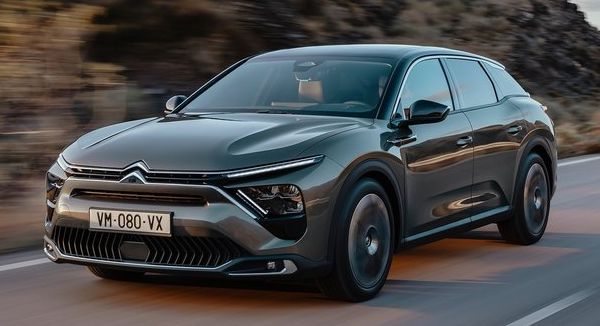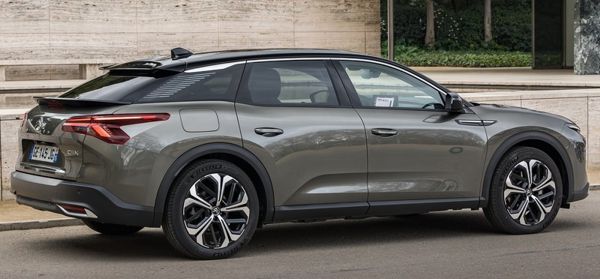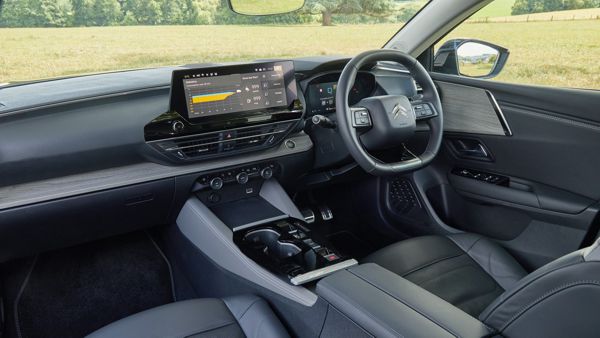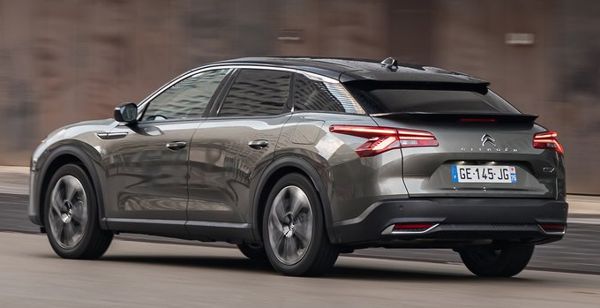Published
on 13
Oct 2022
|
All rights reserved.
|
|
|

|
|
C5X
is a crossover between SUV and conventional estate.
|
|
Surprise, surprise. Slow,
unexciting to drive and not as innovative as we would like a Citroen to
be, the new C5X is actually likable. It may be even competitive thanks
to its practicality and low prices.
Motoring journalists see it as continuation of Citroen large car
tradition like DS, CX, XM and C6. However, in my opinion it has to be
the successor of the mid-size C5, just as its name suggested. The C5X
is not exactly a large car like the aforementioned classics. It is
built on the EMP2 platform of PSA / Stellantis group, something falls
naturally in C and D-segment. Stretching to 4.8 meters long is a bit
over the top, especially when you consider the small and weak engines
powering its front wheels or the torsion-beam rear suspension used on
all models bar PHEV. However, the execution is better than expected, no
matter in styling, interior space, build quality and refinement.
The “X” in its name refers to the crossover pretension. The French car
maker knows conventional saloons are dying and only SUV crossovers sell
well today. However, demand for space, practicality, comfort and fuel
efficiency never ends, so they designed a crossover between SUV and
conventional estate. Ride height is raised and tough body cladding are
added to pretend an SUV, but the roof is kept low at 1485 mm, an estate
body style is adopted to stretch cargo room and – here’s the most
difficult part – styled the car to look stylish and elegant at the same
time. The last one is the most brilliant thing about the car. There are
many recent Citroens (and DS as well) over-styled and looked weird, but
the C5X successfully merges a sleek shape with elegant yet unusual
design details, such as the slim double-chevron grille, the stepped
waistline and decorative patterns on C-pillars. Its drag coefficient of
0.291 is easily better than most SUVs and should help keeping fuel
economy high.

|
|
Have
you ever seen a mid-size car powered by a 3-cylinder engine? As long as
you don't rush, it works. |
|
While the interior is limited by its 2785 mm wheelbase thus is not
quite as spacious as Skoda Superb or Honda Accord, it can easily
accommodate a family with good comfort. The estate body swallows 545
liters of luggage and could be extended to 1640 liters with the rear
seats folded. (PHEV version is weaker at 485 and 1580 liters due to the
rear-mounted 12.4KWh battery). Dropped into the pillowy driver seat,
you face a 7-inch digital display. Next to it is a 12-inch touchscreen
whose infotainment system is responsive and easy enough to use,
if by no means class-leading. Underneath the screen is a row of
physical buttons and knobs for climate control, unlike some rivals
which ditched physical switches altogether. It is worth praising that
the cost-saving measures of PSA / Stellantis does not sacrifice
usability.
Another thing worth praising is the build quality of the cabin. While
it is no BMW or Mercedes, it looks and feels pretty upmarket in terms
of materials used and fit and finish. The dash top is made of soft
plastics, while there are plenty of metal, wood trims and leather to
inject a sense of luxury. Some piano-black surfaces and hard plastics
at less-touched locations still reveal its cost concern, but it is not
unusual, especially when you consider the keen pricing of the C5X. By
the way, this car is built in China. It might help driving down
production cost a little, but the most important is that the sales
volume of Chinese market allows Citroen to bring it to Europe at very
reasonable costs. If relying on European sales alone, Citroen would not
have been greenlighted the project, because there are simply too few
customers in Europe would buy a mid-size car with double-chevron logo.

|
|
Spacious
cabin is practical and pretty upmarket.
|
|
How cheap? The base model starts from £28,000, while PHEV model
tops out at £40,000. The latter sounds expensive, but with a CO2
emission rating of 30 grams each km, it guarantees lower company car
taxes. It goes without saying that the C5X will target strongly at
company car market.
Stellantis’ European engine pool is very limited. The C5X can choose
only between 1.2-liter 3-cylinder turbo with 130 horsepower or
1.6-liter four-cylinder turbo with 180 horsepower, both are branded as
PureTech. The usual 1.6 HDi turbo diesel is not offered here, because,
as mentioned before, this car is built in China. Both petrol engines
are a bit old in the tooth, especially the 1.6-liter unit whose roots
can be traced back to the Hams Hall engine BMW developed for the second
generation Mini in 2006. 180 hp is sufficient for a mid-size family car
without any sporty pretension, as it takes 8.3 seconds to go from rest
to 60 mph when working with the mostly refined Aisin 8-speed automatic.
When driven normally, the engine and transmission combo is pretty
refined. However, when being pushed hard, the small engine reveals its
limitation with a harsh vocal. The Aisin gearbox is no ZF either, which
is evident in its slower gearchange and jerky shift at low speed with
on-off throttle. This might be down to the mediocre calibration of PSA
engineers though.
Sounds like 1.6-liter is not small enough, Citroen estimates most
buyers will opt for the base 3-pot engine. I don’t recall any mid-size
cars employed an engine so small, let alone something with SUV
pretension. You need to be patient with its power delivery, which takes
more than 9 seconds to go from 0-60. However, if you always drive with
a laid-back approach, you will find the 170 pound-foot of peak torque
does a decent job to haul the C5X without feeling strained. Conversely,
if you drive a lot on mountain roads or on the fast lane, then the
1.6-liter engine will be a better option, being smoother, quieter and
more effortless.

|
|
Chassis
majors on comfort, but handling is secured and predictable.
|
|
Opting for PHEV will calm down the engine further. It mates the 180 hp
petrol motor with a 109 hp electric motor and still drives the front
wheels. The electric assistance relieves the load on the engine,
allowing the latter to run within its sweet zone yet offering up to 265
lbft of torque and 225 horsepower. The car is a little quicker to
accelerate than the 180 hp model, but its main advantage is improved
refinement. Only when the engine restarts from the silent background of
electric power will hurt its sense of refinement.
The PHEV is the choice for refinement and running costs, but the 300 kg
of extra weight it carries does blunt its handling, feeling bulkier and
less planted. Admittedly, no C5X models love to be hustled in corners.
Their soft suspension with hydraulic bump stops promote ride comfort,
which is very good indeed. Only large bumps will unsettle it. The
flipside is body control, of course. It rolls a lot in corner and
pitches a lot in braking, although the roll is progressive enough. The
PHEV model gets exclusive multi-link rear axle and adaptive dampers,
which improve ride quality further. The unusually narrow and
tall-sidewall 205/55VR19 tires are hardly a choice for handling, but
the grip they produce is more decent than they look. The steering,
while expectedly light and lacks feel, is precise. The brakes have an
inconsistent pedal feel, but there is nothing wrong with their stopping
power. Overall, the C5X’ chassis is comfort-oriented but it feels also
secured and predictable, very much like older Lexus.
There is nothing wrong for a big family car to choose the comfort
route, it must be said. Not all buyers prefer the sporty character of
German premium cars, and they deserve alternative choices. The Citroen
C5X combines the comfort, space and easy-going manner they demand,
while commanding less money than conventional offerings yet looking
stylish and upmarket. It is worth recommending to those placing driving
thrills at lower priorities.
|
Verdict:     |
|